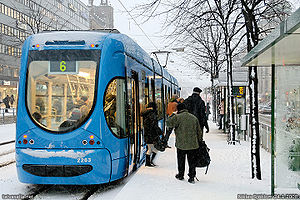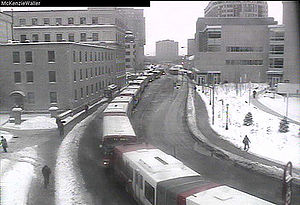Light Rail is not a far-fetched big city thing. It is infrastructure which we need to serve our growing transportation demands and to guide the future development of Waterloo Region.
Shaping Development
By 2031, the region is projected to grow by over 200,000 residents. In the past, the region has been victim to suburban sprawl. Our new Regional Official Plan specifies that 45% of our growth over the next 20 years will be concentrated in developed areas near the cores. In addition, the province has passed new laws to require a reduction in suburban sprawl and an increase in urban intensification. To comply with these new laws, a solution is needed for this 50% population increase.
Light Rail is powerful in its ability to guide future development. Businesses and new developments are attracted to the permanence and capacity of a Light Rail corridor. This causes the anticipated growth in the region to be funnelled into the cores of the cities. Express buses or Bus Rapid Transit would not have the same impact as Light Rail in encouraging the region to grow up instead of out.
Capacity
A Light Rail line has a capacity greater than 16 lanes of free-flowing traffic (Calgary Transit report, p. 7).
In comparison with buses, Light Rail has substantially more capacity, due to the larger vehicles and the ability to couple multiple vehicles together. Ridership along the urban core of Waterloo Region has been growing rapidly, and Regional projections show that a Bus Rapid Transit system would be at capacity before 2031. If an investment in transportation is going to be made, it should be an investment that will last.
Environment
Light Rail will draw more people out of their cars than buses. By virtue of its land-use impacts, it will reduce the suburban sprawl that puts so many cars on the road in the first place. Light Rail, as opposed to buses and cars, releases no air pollution in our cities, and unlike buses and cars, power for a Light Rail system could be obtained from environmentally-friendly sources, reducing overall pollution.
Safety
In 2008, over one thousand people were injured in Waterloo Region as the result of vehicle collisions – 11 collisions were fatal. The more transit is made attractive, and the more our cities are built around transit infrastructure, the less people will need to use their cars. Light Rail allows transportation without the worry of a devastating accident.
Noise and Comfort
Light Rail trains are electrically powered and produce far less noise than buses. Light Rail also releases no noxious exhaust fumes. Potholes and bumpy roads are not an issue with Light Rail, which provides a smooth and comfortable ride.
Cost
The cost of a Light Rail system is not insignificant, but it pales in comparison with the alternatives:
- Projections show an extra 100 lanes of major arterial road will be required within 20 years without Light Rail; building Light Rail reduces the number of needed lanes to 34. In terms of property acquisition, construction, maintenance, snow removal, and accident costs, those 66 lanes of road would have a far greater price tag.
- Oil prices will continue to increase over the coming years, which would directly impact the cost of operating an express bus or Bus Rapid Transit system in lieu of Light Rail.
- Light Rail is far cheaper to operate than buses:
- Tracks and trains are less expensive to maintain than roads and buses.
- While buses are less expensive to buy initially, they carry fewer people per driver, and only last 10-15 years as opposed to 30-40 years for a Light Rail vehicle.
- Though a bus costs less to buy, it is substantially more expensive to power — at present fuel costs. Light Rail uses far less energy due to the low friction of steel wheels on rail, and the energy costs of an Light Rail vehicle, with many times more capacity, is an order of magnitude less than for one bus.
- Since a Bus Rapid Transit system is projected to be at capacity within only 20 years, a Light Rail system would still need to be built. In 20 years the region will have grown significantly, and construction and property acquisition costs will be much higher. Instead of building two systems in succession, the region can save a great deal of money by doing it right the first time by building Light Rail.
The Big Picture
Ultimately, the post-war suburban sprawl model of cities is not sustainable.
Don’t we want to live in a region where:
- our cities are designed for people and not cars?
- green spaces and parks are not turned into parking lots?
- going shopping does not mean worrying about parking?
- air bags, seat belts, child seats, and “Baby On Board” signs are not part of daily living?
- air pollution is not an issue?
- travelling between major destinations is comfortable and without the worry of traffic congestion?


